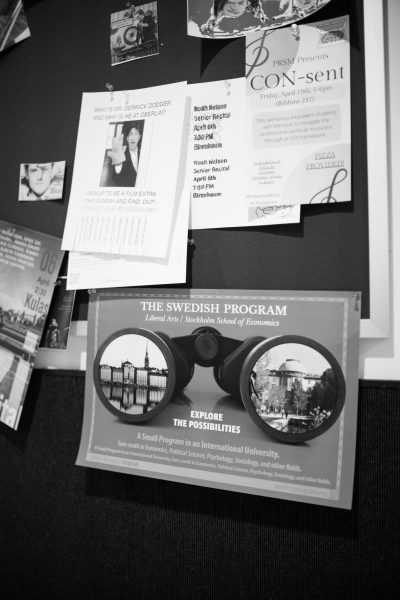Inadequate Facilities Unsafe, Inaccessible For Disabled Students
My most poignant memory from Orientation Week was calling my best friend crying because I thought I would have to leave this school. Classes hadn’t even started yet. There was no academic pressure, and there were many opportunities for social exploration. The reason I thought I had to leave Oberlin was because of its lack of accessibility.
On the third day of orientation, I remember entering Hall Auditorium for the mandatory play, The OC. Even though the building isn’t as old as others on campus, it wasn’t designed with the needs of people like me in mind. As soon as I entered Hall Auditorium, I could smell mold. Mold is an environmental toxin that has especially adverse effects on people with chronic illnesses and suppressed immune systems. For me, extended exposure to toxins like mold triggers an inflammatory response, causing a relapse into my chronic illnesses and requiring a leave of absence. Staying for the entire production simply was not an option.
The stress and frustration of missing mandatory events because I could not physically be in the space were overwhelming. More frustrating than that was the sense of isolation I experienced when I realized how few of Oberlin’s dorms were environmentally safe for me. How could I help my newfound friends understand that it was unsafe for me to hang out in their dorms, especially when there is little awareness of, or nuance about, disabilities on this campus? These are situations that no student should have to navigate in the first place. Students should not be placed in unsafe situations or have to justify their needs in order to be safe.
The most recent issue threatening my ability to attend Oberlin was applying for housing next year. As stated on its website, the Office of Residential Education requires all students with less than six semesters in residence to live on campus. Exemptions are possible, but ResEd maintains that Obies “with physical or medical conditions and/or disability can usually be accommodated in college housing and dining.”
So what happens when the housing options provided by the school aren’t safe? My first choice for housing would be somewhere on South Campus because that is where the majority of people of color are located. However, that isn’t an option for me because those buildings are generally not well-maintained enough to meet my health needs. This difference in building maintenance seems intentionally racialized, since it is mostly POC-designated dorms that seem less maintained.
Because I am not able to live with my of-color community, I was placed in Langston Hall, which on paper did seem to fit my disability needs. However, upon walking into the space, I could smell mold and knew it would not be safe for me to live there. I was told by ResEd that there had not been recent complaints of mold — although I’ve since heard otherwise from people who transferred out of the dorm because of that exact problem.
Living with an administration that forces disabled students to put emotional labor, time, and often money into “proving” their disability is insulting and unbelievably painful. The actions and inactions of this school force disabled students into uncomfortable and unsafe situations, often forcing us to re-examine and re-experience our trauma.
Whether intentional or not, Oberlin constantly sends the message that disabled students aren’t accepted, believed, or wanted. From the exclusive building designs to the racialization of space maintenance, to the lengthy process of obtaining accommodations, students with disabilities must use our energy — which is already quite limited for those of us with chronic illnesses — to constantly advocate for ourselves and prove our existence and validity.
We need to explore the idea that historically marginalized voices have not been believed or respected when they point out injustices and dangerous situations. There is a certain irony in the dismissal of voiced injustice on a campus that claims to be radically liberal and social justice-oriented. I have begun to document the buildings on Oberlin’s campus that violate the Americans with Disabilities Act. I understand that many of these buildings are permissible by legal standards due to grandfather clauses. However, just because something is legal doesn’t mean it’s moral. Laws need to change, and so does Oberlin.
I can’t help but notice the contrast between the rhetoric used to attract prospective students and the reality of student life. In actuality, a portion of Oberlin’s student population cannot live comfortably or safely in College housing. I have heard that students of color have a lower retention rate than white students at Oberlin. I bring this up to acknowledge that it’s more difficult for people of color to get official documentation for disabilities due to the racialization of the medical–industrial complex. For a socially conscious school, Oberlin fails to understand or act upon the nuances of disability and race, as well as the intersection of these identities.
Our social justice legacy did not end with Oberlin’s racial integration. It also includes the continuous harm caused to disabled students of color who are put in potentially dangerous situations by our institution daily. Instead of carelessly throwing around the word “accessibility,” let’s work to educate ourselves on the nuances of disability and push for changes that make our campus safer.
I suggest the administration begin by providing safe housing, respecting the needs of disabled students, and taking universal design — as well as accessibility that includes a wider range of disabilities — into account when making long-term plans for Oberlin’s finances.
To students who claim allyship: Please, work to actively support your disabled friends. Educate yourself, so disabled peers don’t end up in dangerous or uncomfortable situations


